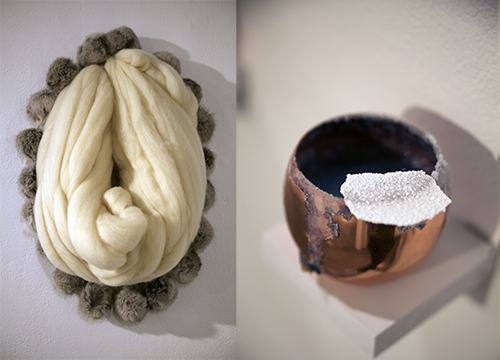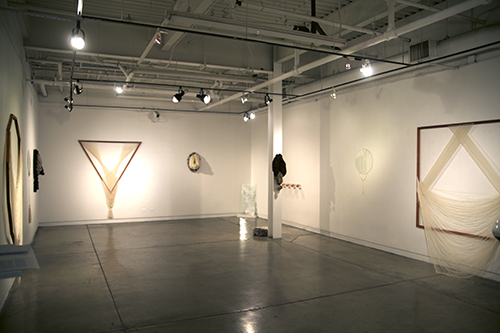 This Friday, April 10th, from 7pm – 9pm, an opening reception will be held for Andrea Santizo’s senior show, Pulling the Strand.
This Friday, April 10th, from 7pm – 9pm, an opening reception will be held for Andrea Santizo’s senior show, Pulling the Strand.
The work ranges in scale and media, from large wooden and wool wall pieces that encompass the viewer, to small copper and salt sculptures that could fit in a child’s hand. Her hybrid objects blend artistic and craft traditions with personal and art historical references. The result is a generous and inviting array of objects that want to shift when you grasp at them but linger in your mind long after the encounter.
In her own words:
As far back as I can remember, there has been a clash between my cultural background and the transplanted American culture in which I was raised. I find myself pushing together what is considered valuable art histories of: frames, prescribed minimalist shapes, drawing and painting, up to traditional textile, fiber, and domestic objects that lack validity within the same art worlds structure in which the formerly mentioned genres reside. In order to form a dynamic exhibition that allows for a critical viewing of such histories, traditions, and acceptable forms of high art, and in doing so directly confronting the polarized art histories and blatant appropriation of traditionally “female” shapes and practices, and questioning the exclusion of craft into the realm of “fine art.”
In works such as Fig. 3 Plaited Triangle, Fig, 10 Draped Decagon, Fig.4 Darted Square, Over & Under (Warp & Weft), and Altar, I am utilizing polygons and their forms that point to minimalist structures as well as traditional weaving tools (i.e. looms and embroidery hoops). Through the imposition of silk thread line work that alludes to the practices of figures like Sol Lewitt and Frank Stella, but directly indexing macramé, weaving, braiding, sewing, sewing pins, thread designs and the implementation of fiber tension, plaiting, draping, darting (all textile, sewing terminology) and referencing artists like Aurelia Muñoz, Mimi Jung, and Victoria Udondian. By creating objects that can translate as painting, sculpture, and drawing, but still fluctuate from that realm to the domestic objects of weaving, macramé, sewing, and ingredients for the kitchen the two disparate worlds are able to come together. In Cowl/Slit I. – IV., there is a direct use of shape to point to female anatomy as well as a placeholder for a portal, an opening, and a different relation to the entering of a work. This along with the juxtaposition of two domestically charged objects made from materials that are correlated with female culture; roving wool for weaving, felting, and craft textile work along with the rabbit fur scarf that is used as a layering, decorative device for the body.
Using “domestic” materials and objects one would typically find in a home refers to the transformative aspects of the commonplace tools in a domestic setting and the alchemical nature of what it takes to run, maintain, and nurture a home as well as an art practice this is reflected in works like Internal Alteration I. – III., Replicating Retainer I. –V., and Calcified Cling.
Through the use of conventionally domestic materials, wood (house), thread (needle work), glass and copper (household items), salt & achiote & cacao beans (domestic consumption products), detergent, sewing pins, finishing nails (furniture hardware), and talismans from Mexico and Guatemala, there is a direct pointing to the mundane object’s transformation to an object of coveted status. Through the use of language and signifiers that have historically been attributed to a male dominated field and by subverting those signifiers through the use of prescribed feminine practices and materials, the conversation about what is and isn’t, has been and hasn’t been art can then emerge.










